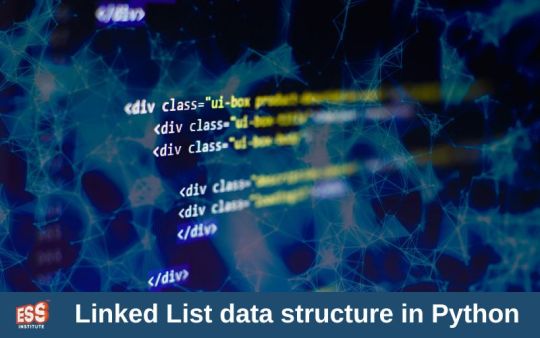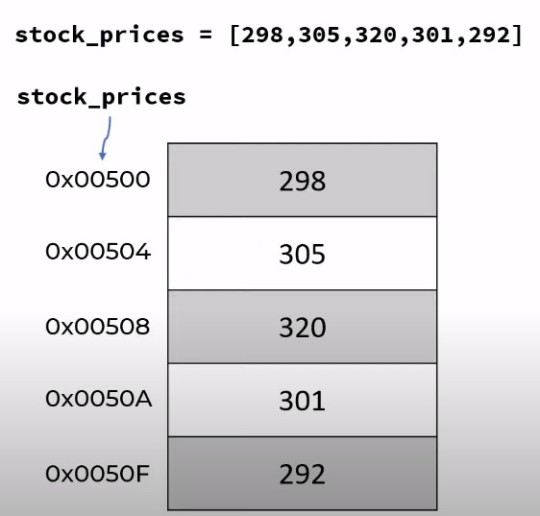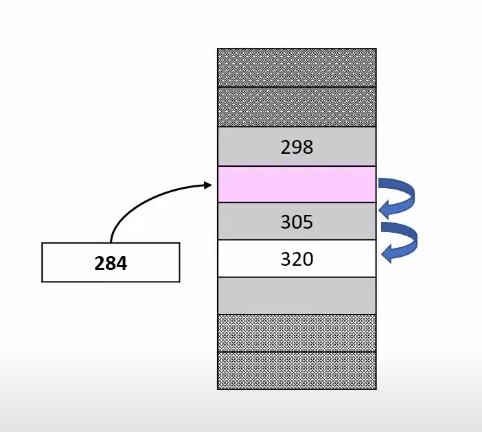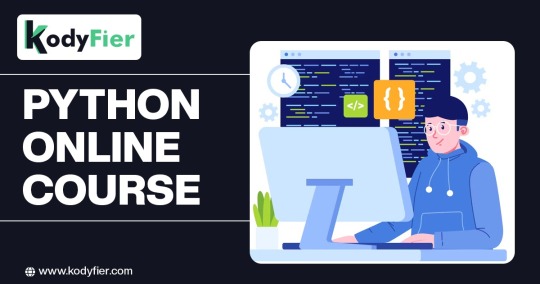#python online course
Explore tagged Tumblr posts
Text
Why Python Will Thrive: Future Trends and Applications
Python has already made a significant impact in the tech world, and its trajectory for the future is even more promising. From its simplicity and versatility to its widespread use in cutting-edge technologies, Python is expected to continue thriving in the coming years. Considering the kind support of Python Course in Chennai Whatever your level of experience or reason for switching from another programming language, learning Python gets much more fun.

Let's explore why Python will remain at the forefront of software development and what trends and applications will contribute to its ongoing dominance.
1. Artificial Intelligence and Machine Learning
Python is already the go-to language for AI and machine learning, and its role in these fields is set to expand further. With powerful libraries such as TensorFlow, PyTorch, and Scikit-learn, Python simplifies the development of machine learning models and artificial intelligence applications. As more industries integrate AI for automation, personalization, and predictive analytics, Python will remain a core language for developing intelligent systems.
2. Data Science and Big Data
Data science is one of the most significant areas where Python has excelled. Libraries like Pandas, NumPy, and Matplotlib make data manipulation and visualization simple and efficient. As companies and organizations continue to generate and analyze vast amounts of data, Python’s ability to process, clean, and visualize big data will only become more critical. Additionally, Python’s compatibility with big data platforms like Hadoop and Apache Spark ensures that it will remain a major player in data-driven decision-making.
3. Web Development
Python’s role in web development is growing thanks to frameworks like Django and Flask, which provide robust, scalable, and secure solutions for building web applications. With the increasing demand for interactive websites and APIs, Python is well-positioned to continue serving as a top language for backend development. Its integration with cloud computing platforms will also fuel its growth in building modern web applications that scale efficiently.
4. Automation and Scripting
Automation is another area where Python excels. Developers use Python to automate tasks ranging from system administration to testing and deployment. With the rise of DevOps practices and the growing demand for workflow automation, Python’s role in streamlining repetitive processes will continue to grow. Businesses across industries will rely on Python to boost productivity, reduce errors, and optimize performance. With the aid of Best Online Training & Placement Programs, which offer comprehensive training and job placement support to anyone looking to develop their talents, it’s easier to learn this tool and advance your career.

5. Cybersecurity and Ethical Hacking
With cyber threats becoming increasingly sophisticated, cybersecurity is a critical concern for businesses worldwide. Python is widely used for penetration testing, vulnerability scanning, and threat detection due to its simplicity and effectiveness. Libraries like Scapy and PyCrypto make Python an excellent choice for ethical hacking and security professionals. As the need for robust cybersecurity measures increases, Python’s role in safeguarding digital assets will continue to thrive.
6. Internet of Things (IoT)
Python’s compatibility with microcontrollers and embedded systems makes it a strong contender in the growing field of IoT. Frameworks like MicroPython and CircuitPython enable developers to build IoT applications efficiently, whether for home automation, smart cities, or industrial systems. As the number of connected devices continues to rise, Python will remain a dominant language for creating scalable and reliable IoT solutions.
7. Cloud Computing and Serverless Architectures
The rise of cloud computing and serverless architectures has created new opportunities for Python. Cloud platforms like AWS, Google Cloud, and Microsoft Azure all support Python, allowing developers to build scalable and cost-efficient applications. With its flexibility and integration capabilities, Python is perfectly suited for developing cloud-based applications, serverless functions, and microservices.
8. Gaming and Virtual Reality
Python has long been used in game development, with libraries such as Pygame offering simple tools to create 2D games. However, as gaming and virtual reality (VR) technologies evolve, Python’s role in developing immersive experiences will grow. The language’s ease of use and integration with game engines will make it a popular choice for building gaming platforms, VR applications, and simulations.
9. Expanding Job Market
As Python’s applications continue to grow, so does the demand for Python developers. From startups to tech giants like Google, Facebook, and Amazon, companies across industries are seeking professionals who are proficient in Python. The increasing adoption of Python in various fields, including data science, AI, cybersecurity, and cloud computing, ensures a thriving job market for Python developers in the future.
10. Constant Evolution and Community Support
Python’s open-source nature means that it’s constantly evolving with new libraries, frameworks, and features. Its vibrant community of developers contributes to its growth and ensures that Python stays relevant to emerging trends and technologies. Whether it’s a new tool for AI or a breakthrough in web development, Python’s community is always working to improve the language and make it more efficient for developers.
Conclusion
Python’s future is bright, with its presence continuing to grow in AI, data science, automation, web development, and beyond. As industries become increasingly data-driven, automated, and connected, Python’s simplicity, versatility, and strong community support make it an ideal choice for developers. Whether you are a beginner looking to start your coding journey or a seasoned professional exploring new career opportunities, learning Python offers long-term benefits in a rapidly evolving tech landscape.
#python course#python training#python#technology#tech#python programming#python online training#python online course#python online classes#python certification
2 notes
·
View notes
Text
PYTHON - Code With Josh ...
youtube
Post #163: YouTube, Free Python course for beginner, Code with Josh, 2025.
#programming#education#coding#i love coding#coding is fun#learning#i love programming#i love python#programming language#teaching#learn python#educacion#python online course#python coding#python tutorial#Youtube
3 notes
·
View notes
Text
https://www.trangran.com/features-of-python-career-in-it/
Python is a versatile, easy-to-learn programming language known for its simplicity and readability. It supports multiple programming paradigms, including object-oriented, functional, and procedural styles. Python has a rich ecosystem with libraries like NumPy, Pandas, and TensorFlow, making it ideal for data science, machine learning, web development, automation, and more.
0 notes
Text
Why Python is the Most Used Language for Machine Learning
Python is a high-level, general-purpose programming language widely recognised for its readability and simplicity. Guido van Rossum developed it in the late 1980s, and it supports multiple programming paradigms, including procedural, object-oriented, and functional programming. Python has become the most popular programming language for machine learning (ML), particularly resonating with students and aspiring developers in India, especially in a tech-forward city like Delhi. Here's an in-depth look at why python institute in Delhi is the preferred choice for ML.

5 Reasons Why Python is the Most Used Language
Python has quickly become the most popular language for a wide range of applications, especially in machine learning and data science. Here are five key reasons why Python dominates the programming landscape.
Extensive Libraries and Frameworks
Python offers a vast ecosystem of libraries and frameworks that streamline various machine learning tasks. Some of the most notable ones include:
NumPy: Essential for numerical computations and handling arrays.
Pandas: Excellent for data manipulation and analysis.
Scikit-learn: Provides tools for data mining and machine learning algorithms.
TensorFlow and PyTorch: Popular frameworks for deep learning applications.
These libraries dramatically reduce the amount of code required to implement complex algorithms, allowing developers to build models more efficiently.
Strong Community Support
Python, being open-source, has built a large community of developers who continually contribute to its libraries and frameworks. This community ensures that learners can easily find resources, tutorials, and forums to resolve issues and improve their skills. The collaborative environment promotes knowledge sharing, making it easier for students to learn from one another.
Cross-Platform Compatibility
Python’s platform independence allows developers to write code on one operating system and run it on another without modification. This feature benefits students who may not have access to high-end machines or specific operating systems. They can develop their projects on any platform—whether Windows, macOS, or Linux—making Python more accessible to a wider audience.
Flexibility and Scalability
Python’s versatility allows it to be used in a range of applications beyond machine learning, such as web development, data analysis, and automation. This flexibility means students can apply their Python skills across different domains. As projects grow in complexity, Python’s scalability helps developers manage large codebases without sacrificing performance or readability.
Reduced Development Time
Compared to languages like Java or C++, Python allows for faster development cycles. Python code typically requires fewer lines than other languages, enabling developers to implement features more quickly. This efficiency is especially valuable in the fast-paced world of machine learning, where prototyping and iteration are crucial.
Why is Python More Readable than Other Languages?
Python is often regarded as more readable than other programming languages due to several characteristics that enhance its clarity and ease of understanding. Here are the key reasons why Python stands out in terms of readability:
Simple and Clear Syntax
Python’s syntax is straightforward and intuitive, making it resemble natural language. This simplicity allows developers to express concepts in fewer lines of code than languages like C++ or Java, where verbosity often hides the logic. For example, Python uses indentation to define code blocks, eliminating the need for braces or keywords that can clutter the code.
Minimal Boilerplate Code
In Python, developers can accomplish tasks with minimal boilerplate code. This allows them to focus more on the core logic of the programme, with fewer distractions. Python’s high-level nature encourages abstract thinking, translating into cleaner, more maintainable code.
Use of Whitespace
Python enforces a disciplined coding style through its requirement for indentation, promoting a clean visual structure. This use of whitespace makes it easier to follow the programme's flow, which is particularly beneficial for beginners still learning programming concepts.
Should You Study Python?
Python training in Delhi is highly beneficial for students and professionals. Its simplicity makes it an excellent choice for beginners. Its applications span web development, data science, artificial intelligence, and machine learning, all of which are increasingly relevant in today’s job market.
In India, the demand for Python developers continues to soar. Companies are actively seeking skilled professionals who can leverage Python’s capabilities to drive innovation and efficiency. On average, a Python developer in India earns around ₹5,28,500 per annum, with potential earnings reaching up to ₹15 lakhs, depending on experience and expertise.
Conclusion
Python’s syntax prioritises clarity, using indentation to define code blocks, which makes it easy to read and maintain. Its extensive standard library equips developers to handle a wide range of tasks, from web development to data science and automation. Additionally, Python’s robust community provides extensive support, ensuring ample resources for learners at all levels. With its wide range of applications and growing demand in the Indian job market, python courses from ESS Institute offer immense opportunities for career growth.
0 notes
Text
https://followingbook.com/post/193813_python-online-classes-master-coding-with-kodyfier-in-india-if-you-039-re-eager-t.html

#python online classes#python online class#python online classes in india#python online course#python online training#kodyfier
0 notes
Text
Linked Lists in Python | Python Institute in Delhi

Linkedlist is one of the most complex data structure which is difficult to understand for new programmers as well as professionals. So, In this article by a trainer from python institute in Delhi, you will learn about linkedlist in detail
We’ve all heard of data structures in python, and linked lists are among the most important data structures for both interviews and your coding journey. We will go through various operations on the linked list and the Big O complexities as well. Before we get into the liked list, we need to look into array because there are some issues with arrays that linked list try to solve.
Let us say, we have an array of stock prices and have a memory layout of these stock prices as shown.
Array in Python and its disadvantages


When you create an empty list in Python, Internally in the memory it will allocate some capacity for that list.
It is allocating a capacity of five elements and when you start inserting elements one by one, it will put those values in. Now at this stage when you have three elements and you want to insert 284 at location number 1, what really happens is, firstly it will swap the value at that place to make a space for 284. Here, you can see that there are 2 copy operations while doing this. Read more
#digital marketig course#python course online#python institute in Delhi#online seo course in hindi#Python online course#Python institute in Delhi
0 notes
Text

Unlock the power of Python with eMexo Technologies in Electronic City, Bangalore! 🚀🐍 Explore hands-on coding, learn from industry experts, and join a community of success stories. Ready to take the next step? Enroll now for the Best Python Training Institute In Electronic City Bangalore.🎓💻
More details: https://www.emexotechnologies.com/courses/python-certification-training-course/
Reach us 👇
📞 +91 9513216462
🌐http://www.emexotechnologies.com
🌟 Why Choose eMexo Technologies?
Expert Trainers
Hands-on Learning
Industry-Relevant Curriculum
State-of-the-Art Infrastructure
https://youtu.be/Rt9pTK8MMUw?si=-MNzSFgLp-Qj98Pz You can see this video you get clear clarification about the course.
🔥 Python Course Highlights:
Comprehensive Syllabus
Real-world Projects
Interactive Sessions
Placement Assistance
🏆 Best Python Training Institute in Electronic City, Bangalore!
Our commitment to excellence makes us the preferred choice for Python enthusiasts. Get ready to embrace a learning experience like never before.
📆 Enroll Now! Classes are filling up fast!
📌 Location: #219, First Floor, Nagalaya, 3rd Cross Road, Neeladri Nagar, Electronics City Phase 1, Electronic City, Bengaluru, Karnataka 560100
#pythontraininginbangalore#python course#python training#python developers#python#pythontraininginstituteinelectroniccity#pythoncourseinelectroniccity#besttraininginstituteinelectroniccitybangalore#python online course#python online training#python certification#emexotechnologies#electroniccity#bangalore#course#traininginstitute#education#learning#training#careers#jobs#studyblr#programming
0 notes
Text
Master Python with the Best Online Course
Elevate your programming prowess with our top-rated Python course. From basic syntax to advanced algorithms, sharpen your skills and become a proficient Python programmer ready to tackle any challenge.
#python classes#python course#python online training#python online course#python training#neuailabs#futureofai
0 notes
Text
Mastering UI Development and Python: Unlocking Your Coding Potential
In the fast-paced digital landscape, UI developers play a pivotal role in creating seamless and visually stunning user experiences. Our UI developer online course is crafted to empower you with the skills needed to thrive in this dynamic field.
The Basics: Navigating the UI Developer Course
Embark on your coding journey by mastering the fundamentals. From HTML and CSS essentials to responsive design principles, this course lays the groundwork for your success. Unlock the secrets behind creating intuitive interfaces that captivate users.
Advanced Techniques: Elevate Your UI Development Game
Take your skills to the next level with advanced UI development techniques. Delve into JavaScript frameworks like React and Vue.js, gaining the expertise to build interactive and dynamic user interfaces. Our hands-on approach ensures you apply your knowledge in real-world scenarios.

UI/UX Harmony: Creating User-Centric Designs
A great UI developer understands the symbiotic relationship between user interface (UI) and user experience (UX). Learn how to design interfaces that not only look impressive but also enhance the overall user journey. Elevate your projects with user-centric design principles.
Python Mastery: A Language for Innovators
Welcome to the Python Online Course
Python, a language renowned for its simplicity and versatility, opens doors to endless possibilities. Join our python online course to unleash the true potential of this programming language.
Python Fundamentals: Building a Strong Foundation
Begin your Python journey by grasping the fundamentals. From variables and data types to control flow structures, this course ensures you have a solid foundation. Navigate the Python landscape with confidence.
Beyond Basics: Advanced Python Programming
Take a deep dive into advanced Python concepts. Explore object-oriented programming, data manipulation with NumPy and Pandas, and the power of Python libraries. Acquire the skills needed to tackle complex coding challenges.
Supporting the Coding Community
Conclusion: Your Coding Odyssey Begins
Embark on a transformative journey with our UI developer and Python online courses. Whether you're a novice or a seasoned coder, our courses cater to all skill levels. Uncover the secrets of UI development and harness the power of Python, propelling yourself into the realm of coding excellence. Enroll now and let your coding odyssey begin!
0 notes
Text
Python for Beginners in 2025: Key Benefits and Career Opportunities
Python continues to be a top choice for beginners entering the world of programming in 2025. Its simplicity, versatility, and widespread use across industries make it a practical and rewarding language to learn. Considering the kind support of Python Course in Chennai Whatever your level of experience or reason for switching from another programming language, learning Python gets much more fun.

Whether you want to build websites, analyze data, or explore artificial intelligence, Python is a strong foundation to start with. Here’s why Python remains a smart investment for your future in tech.
Simple and Beginner-Friendly Python’s syntax is clean, readable, and closely resembles everyday English, which helps beginners understand programming logic without getting overwhelmed. You can start writing useful code quickly, even with little to no prior experience, making it ideal for those new to coding.
Versatile Applications One of Python’s standout features is its versatility. It’s used in many areas, including web development, data science, machine learning, automation, game development, and even cybersecurity. This means that by learning one language, you open doors to a variety of career paths and projects.
High Demand in the Job Market Python remains one of the most sought-after skills in the tech job market. Employers look for Python developers across startups, established tech companies, and industries such as finance, healthcare, and retail. With Python on your resume, you increase your chances of landing interviews and high-paying job opportunities. With the aid of Best Online Training & Placement Programs, which offer comprehensive training and job placement support to anyone looking to develop their talents, it’s easier to learn this tool and advance your career.

Strong Community and Learning Resources Python has a huge and active global community. Beginners can benefit from forums, tutorials, documentation, and peer support. If you get stuck or want to try something new, there’s always help available. The abundance of resources makes self-learning more accessible and less intimidating.
Excellent for Career Growth Once you learn the basics, Python lets you grow into more advanced areas. You can explore frameworks like Django and Flask for web development, or dive into libraries like Pandas, NumPy, and TensorFlow for data and AI projects. This scalability helps you evolve as a developer and specialize in high-growth fields.
Future-Proof Skill As technology trends evolve, Python keeps adapting. It’s already a leader in AI and data science, and it's increasingly used in emerging fields like automation, IoT, and blockchain. Learning Python means you’re investing in a skill that will remain valuable for years to come.
Conclusion In 2025, Python is still one of the best programming languages for beginners. It’s easy to learn, highly versatile, and opens up a world of career possibilities. Whether you’re starting from scratch or switching careers, learning Python can be your first step toward a successful future in the tech industry.
#python course#python training#python#technology#tech#python programming#python online training#python online course#python online classes#python certification
0 notes
Text
What steps can I take to get ready for a data science course prior to enrolling?
The promising discipline of data science combines statistics, machine learning, and data analysis to analyze large databases for insightful information. It's crucial to get ready for the future journey if you're preparing to start a data science degree. You may use this article as a guide to prepare for a data science course before enrolling.
1. Strengthen Your Math and Statistics Fundamentals
Statistical analysis and mathematical ideas are fundamental to data science. Be sure you understand the fundamentals of algebra, calculus, and probability before enrolling in a data science course. Learn about statistical concepts such as standard deviation, mean, median, and hypothesis testing. You may improve your math's and statistics abilities for free by using resources like Coursera and Khan Academy.
2. Learn Programming Languages
Programming is at the heart of data science. Python and R are the most commonly used languages in the field. Familiarize yourself with the basics of at least one of these languages. Online tutorials and coding platforms like Nearlearn, Codecademy or DataCamp provide interactive courses to get you started. Learning the basics of data manipulation, visualization, and statistical analysis in your chosen language is a great start.
3. Get Comfortable with Data Tools
Data science often involves working with large datasets. Tools like Jupyter Notebook, pandas, and NumPy in Python, or libraries like dplyr and ggplot2 in R, are essential for data manipulation and visualization. Explore these tools and practise with sample datasets to become proficient in data handling and analysis.
4. Understand Data Cleaning
Data is rarely perfect; it often requires cleaning and preprocessing. Familiarize yourself with techniques for data cleaning, such as handling missing values, outliers, and data imputation. Learning how to prepare data for analysis is a crucial skill in data science.
5. Explore Online Courses and Resources
Before enrolling in a formal course, take advantage of free online courses and resources. Platforms like Coursera, edX, and Udacity offer introductory data science courses. These courses will give you a taste of what to expect and help you determine if data science is the right path for you.
6. Practice Problem Solving
Data science is about solving complex problems. Engage in problem-solving challenges on platforms like Kaggle and LeetCode. These platforms offer real-world data science problems and coding challenges. They're a great way to apply your knowledge, learn from others, and build your problem-solving skills.
7. Read Relevant Books and Blogs
Explore books like "Python for Data Analysis" by Wes McKinney and "Introduction to Statistical Learning" by Gareth James. Blogs like Towards Data Science, Data Science Central, and FlowingData provide valuable insights and the latest trends in data science.
8. Build a Portfolio
Create a portfolio of data science projects. Even if they're small, hands-on projects, they demonstrate your practical skills to potential employers. Share your portfolio on platforms like GitHub to showcase your work.
9. Connect with the Data Science Community
Join data science forums, attend meetups, and follow data scientists on social media. Networking with others in the field can provide valuable insights and connections that can benefit your journey in data science.
10. Set Clear Goals
Before enrolling in a data science course, define your goals. Understand why you want to pursue data science and what specific areas or industries interest you. Setting clear objectives will help you choose the right course and focus your efforts on what matters most to you.
By following these steps and dedicating time to prepare for your data science course, you'll be better equipped to grasp the concepts and excel in your studies. Remember that the world of data science is vast and ever-evolving, so stay curious, persistent, and eager to learn. Your journey in data science awaits!
#data science training#data science classroom training#data visualization#data analytics#python training#python online course
1 note
·
View note
Text
Python certification offers numerous advantages, especially in today’s tech-driven world. It validates your proficiency in Python, a versatile and in-demand programming language widely used in fields like Data Science, Web Development, and Automation. Earning certification boosts your resume, enhancing job prospects by demonstrating your practical coding skills to employers.
0 notes
Text

Professional online web design course for beginners covering every aspect of website desiginig using HTML, CSS and javascript with live examples.
#Best Computer Institute in Delhi#Web development institute in delhi#learn website design#basic computer course#Python programing institute#Python institute in Delhi#Python online course
0 notes
Text
https://twikkers.nl/blogs/228499/Python-Online-Course-with-Kodyfier-The-Premier-Training-Experience-in

#Python Online Course#Python Online Courses#Python Online Course in India#Python Online Classes#Python Online Training#Kodyfier
0 notes
Text
The Future of Python: Trends and Emerging Technologies
Python, a versatile and user-friendly programming language, has witnessed explosive growth in popularity over the years. Its simplicity, readability, and a vast ecosystem of libraries and frameworks have made it a favorite among developers and data scientists alike. But what does the future hold for Python? In this blog post, we'll explore the emerging trends and technologies that are shaping the future of Python.
1. Machine Learning and Artificial Intelligence (AI)
Python has already established itself as the go-to language for machine learning and AI development, thanks to libraries like TensorFlow, PyTorch, and scikit-learn. In the future, we can expect Python's dominance in this field to grow even further. As AI continues to permeate various industries, Python's robust ecosystem and community support will keep it at the forefront of AI innovation.
2. Web Development
Python's web development frameworks like Django and Flask have gained significant traction, and this trend is set to continue. Django's scalability and versatility make it an excellent choice for building web applications, while Flask's simplicity appeals to developers seeking a lightweight framework. Python's role in web development will only become more pronounced as it continues to evolve.
3. Data Science and Big Data
Python's prowess in data science, data analysis, and visualization has led to its widespread adoption in the field. With the rise of big data, Python's libraries, including pandas, NumPy, and Matplotlib, will remain indispensable tools for data professionals. Moreover, Python is well-suited for processing and analyzing vast datasets, making it an essential language in the era of big data.
4. Internet of Things (IoT)
As the Internet of Things expands, Python is increasingly being used to develop applications and manage IoT devices. Its simplicity and extensive libraries make it a top choice for IoT projects. Python's ability to connect devices, collect data, and analyze information from sensors will continue to drive its role in IoT development.
5. Quantum Computing
Quantum computing is on the horizon, and Python is poised to play a vital role in this emerging field. Libraries like Qiskit and Cirq allow developers to experiment with quantum algorithms and quantum hardware. As quantum computing advances, Python's accessibility will enable more developers to explore this exciting frontier.
6. Cross-platform Development
Python's cross-platform compatibility is a significant advantage. With libraries such as Kivy and BeeWare, developers can build native applications for multiple platforms from a single codebase. This trend will gain momentum as developers seek efficient ways to target diverse devices and operating systems.
7. Automation and Scripting
Python's scripting capabilities have always been a strength. In an increasingly automated world, Python's versatility will continue to shine. It will remain the go-to choice for tasks like scripting, task automation, and process optimization.
8. Education and Community Growth
Python's simplicity and readability make it an ideal choice for teaching programming. Its educational use will continue to grow, nurturing a new generation of Python enthusiasts. Additionally, Python's strong global community will ensure its continuous development and adaptation to emerging needs.
In conclusion, Python's future is bright and filled with opportunities. Whether you're interested in AI, web development, data science, IoT, quantum computing, or simply automating everyday tasks, Python will remain a reliable and powerful tool. Its adaptability and community support ensure that it will stay at the forefront of technological advancements for years to come.
As you embark on your Python journey or consider its role in your projects, keep an eye on these emerging trends and technologies. Python's ability to evolve and stay relevant in the ever-changing tech landscape is a testament to its enduring appeal and utility. Embrace the future of Python, and you'll be well-prepared for the exciting developments that lie ahead.
#Python certification training#Python online course#Python certification training course#Python online course with certification#Python Online Training#Python Online Certification Course#Python Training course#Python Certification Training course#Python Online Training Course
0 notes
Text

Enroll in our Python Online Course and earn a certification to enhance your programming skills. This comprehensive program covers Python fundamentals, advanced topics, and practical applications. Whether you're a beginner or an experienced developer, our course offers expert guidance and hands-on projects to help you master Python. Upon completion, you'll receive a recognized certification, validating your proficiency in Python programming and opening doors to exciting career opportunities. Don't miss this chance to boost your coding prowess and credentials – join our Python Online Course today!
0 notes